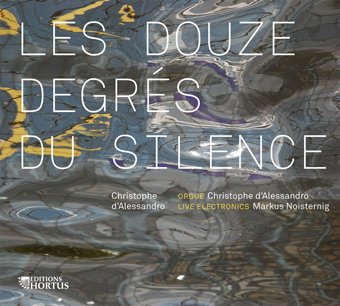
Les douze degrés du silence – 25'10
Symphonie de l’empereur jaune – 42'37
T.T. 67'52
Published with the help of the Fcm, l’Adami, Scpp and the CNRS – LIMSI, with the support of the Association de Promotion de la Musique en Limousin (APML).
Ref. Hortus096
ORGAN & LIVE ELECTRONICS
LES DOUZE
DEGRÉS
DU SILENCE
CHRISTOPHE D’ALESSANDRO, COMPOSITION & ORGAN
MARKUS NOISTERNIG, LIVE ELECTRONICS
WORLD PREMIERE
Suret-Giroud organ at Sainte-Élisabeth church (Paris, France)
CD price: € 19.00 including international shipping
Payment via Paypal.fr - Account : editionshortus@wanadoo.fr
Take a historical pipe organ, insert microphones in the buffets, add a touch of real-time digital processing… Let the whole mix and blend it with the organ sound in the acoustic space of the room… Let’s experience the sound of this new and unusual music, combining musical heritage and new technologies!
Les douze degrés du silence : A piece made of twelve short episodes inspired by “the twelve degrees of silence” Dorothée Quoniam (in religion Sister Marie-Aimée de Jésus, 1839-1874).
Symphonie de l’Empereur jaune : A free comment of a short extract from Zhuangzi, essential taoïst text (4th-c), forming a suite of fifteen episodes in five movements.
CHRISTOPHE D’ALESSANDRO,
COMPOSITION & ORGAN
Christophe d’Alessandro (born in Marseille on 16 December 1961) began studying piano in 1968, with Lucien Pipereaut. From 1977 he studied harpsichord and early music with Richard Siegel and Guy Robert, then organ and improvisation with Suzanne Chaisemartin and Denys Mathieu-Chiquet, and played keyboards in various rock bands and free jazz groups. Christophe d’Alessandro studied composition with Luc Ferrari, harmony, counterpoint and analysis with Jean-Michel Bardez and Solange Ancona.
His early interest in musical creation and research lead him to study mathematics and computer science. He joined the CNRS in 1989, where he is currently Director of Research, Head of the Audio & Acoustics group at LIMSI-CNRS. He has published many works on the analysis and synthesis of voice, speech, organology, instrumental gesture and computer music.
Appointed assistant organist in 1988 and titular organist in 1992 at Sainte Élisabeth, Christophe d’Alessandro is regularly invited as a performer and improviser, and has recorded for radio and television programmes.
He is a member of the Historic Organ Committee of the French Ministry of Culture. Christophe d’Alessandro’s music is influenced by his works on language and gestures: vocalic colours and timbres, speech prosody, consonantal rhythms.
MARKUS NOISTERNIG,
LIVE ELECTRONICS
Born in Salzburg in 1974, he takes both artistic and scientific interest in matters of sound and music. He studied computer music composition at the University of Music and Performing Arts as well as Electrical Engineering and Audio Engineering at the University of Technology in Graz, Austria. From 2003 to 2007 he was a Research Scientist at the Institute of Electronic Music and Acoustics (IEM) in Graz, and in 2007 at LIMSI-CNRS, Orsay, France. Since 2008, he has been a Researcher at the Acoustic and Cognitive Spaces Research Group at IRCAM, Paris, France. He is also Senior Lecturer at the IEM. Markus Noisternig has performed at international festivals and worked with well-known composers like Olga Neuwirth, Peter Ablinger and Philippe Schoeller, and well-reputed orchestras such as Klangforum Vienna, Ensemble Modern Frankfurt and Musikfabrik. He worked as record and mastering engineer for Kairos Music, among others; his recording of Olga Neuwirth’s opera Lost Highway was awarded the Diapason d’or.